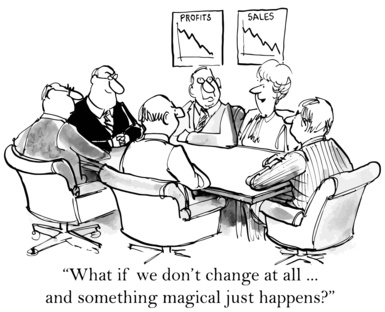As Business Analysts, we are usually dubbed as “Change Agents”. The challenge, though, is that most of us find this role very bewildering and, even, distressing.
 Most business analysts hail from IT or finance backgrounds, with little or no formal training in psychology, HR, or organizational development. Subsequently, they view the topics of change management as incredibly fuzzy and blurry ones. Furthermore, change management topics usually entail high level of uncertainty, which might goes against our methodical way of thinking, which usually prefers order, predictability, and structure.
Most business analysts hail from IT or finance backgrounds, with little or no formal training in psychology, HR, or organizational development. Subsequently, they view the topics of change management as incredibly fuzzy and blurry ones. Furthermore, change management topics usually entail high level of uncertainty, which might goes against our methodical way of thinking, which usually prefers order, predictability, and structure.
In his seminal book “Business Analysis: Best Practices for Success”, Steven P. Blais defined the Change Agent role as “The business analyst is explicitly or implicitly responsible for the successful adoption of changed processes, products, and technologies in the organization… as a business analyst, you have to understand the business community and its ability to absorb the change.” The main notion here is “the ability of absorb the change”, because every organization can absorb different amounts of change due to many factors: culture, trust, management style, workload, etc.
Most business analysts, intentionally or unintentionally, are used to turn their backs on assessing the ability of the organization to absorb the change, as they prefer to focus completely on the technical part of the job, namely the requirements engineering. Basically, they suppose that this work must be on the to-do list of the project manager as part of the “stakeholders management”. The truth is: project manager is concerned with the stakeholders who affect the delivery of the project, not with the stakeholders who get affected by the outcomes of the project.
In order to have the guts to assume this role successfully, a business analyst must first be equipped with the minimum practical grasp of the concepts of change management, in such a way to incorporate these concepts in his/her daily work, and this is the purpose of this series of articles.
Firstly, it is highly important to make a distinction between the three types of change management (as explained in “BPM CBOK Version 3.0: Guide to the Business Process Management Common Body of Knowledge”):

The Strategic Change Managmenet is more concerned with the business model of a company. That is, how to generate more profits, become more socially-aware, etc. This type of change usually leads to entering new markets, developing new products, improving the business processes, creating new brand, merger, restructuring, etc.
IT Change Management is usually very well-known for IT professionals (including IT business analysts), as it defines the processes of how IT stuff manage the change to IT systems (applications, infrastructure, communication, etc.) to ensure the minimum disruption of business operations and impact on users. Here we talk about ITIL, Capability Maturity Model, Microsoft Operations Framework, etc.
The third form –which is the focus of this series- is the Organizational Change Management. This type is a must if we want to ensure that the two previous types are rolled out smoothly and properly in an organization. It addresses the people-side of change, and uses a set of tools to help an organization and its people transition from a current state to a sustainable target state.
When it comes to organizational change management, it is extremely important to understand the 3 levels of change (put forth by Esther Cameron & Mike Green in their comprehensive book on the subject “Making Sense of Change Management: A Complete Guide to the Models, Tools and Techniques of Organizational Change”):
Individual level (personal level), group level (team level), and organization level (enterprise level). According to these 3-levels scheme, the individual change is at the heart of everything that is achieved in organizations. However, individuals are governed by the norms and dynamics of the groups they belong to. The groups, in turn, are bound together in a whole system of groups of people that interact and interplay in the context of the whole organization and the surrounding ecosystem (national norms and values).

In the next article of this series, we will focus on the very core concepts of change management at the individual-level, and how we must leverage this knowledge during our business analysis work.
Author: Zaher Alhaj Hussein, Consultant & Business Analyst
Certified Business Analysis Professional (CBAP®) 2010; TOGAF® 9 Certified, 2012; Prosci Change Management Certified, 2014; and Certified Business Intelligence Professional (CBIP®) 2014.
References
Steven Blais. “Business Analysis: Best Practices for Success”. Wiley; 1 edition (November 8, 2011).
Tony Benedict, et al. “BPM CBOK Version 3.0: Guide to the Business Process Management Common Body Of Knowledge”. CreateSpace Independent Publishing Platform; Version 3.0, Third Edition edition (September 1, 2013).
Esther Cameron, Mike Green. “Making Sense of Change Management: A Complete Guide to the Models, Tools and Techniques of Organizational Change”. Kogan Page; Third Edition edition (June 15, 2012).
Cartoon image © cartoonresource - Fotolia.com